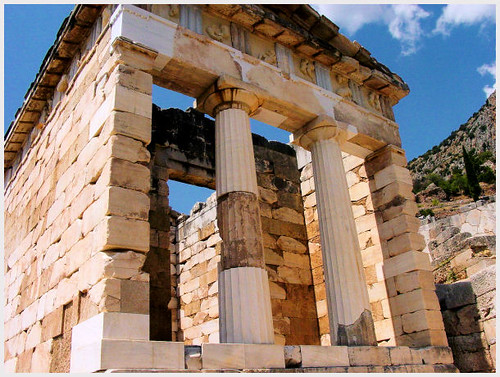
Image : http://www.flickr.com
The Greek god of the sea, Poseidon, fell in love with
the beautiful nymph, Korkyra. As gods often did, he
simply kidnapped a bride, and whisked her off to an
unnamed island where they enjoyed a time of marital
bliss. Poseidon was so enamored of his lovely wife;
he offered to name the island for her - Korkyra, which
is now better known as Corfu Island Greece.
And this is Corfu island - a romance between beauty and
power, intimately tied to the water. The island's
position between the mainland of Greece and Western
Europe has made it a perfect geographic stepping
stone, as well as a target for the Persians,
Sicilians, Romans, Venetians, Turks, French, and
British. In 1864, Corfu Island was finally ceded to Greece,
in accordance with the Corfiots most ardent wishes.
The history of ongoing battles and conquests can still
be deciphered today. It is seen in the two castles
enclosing the main city of Corfu Greece, still called Kerkyra Greece
by the Greeks.
The more commonly known name, Corfu, comes from the
Italian corruption of the word koryphai, which means
crests. Again, this refers to the site of the two fortresses.
Corfu Greece is an Ionian Island, a 60 km long sickle shaped
formation with its hollowed side looking toward
Albania. The island is separated from Albania by
straits varying from 3 to 23 km across. This
protected side, on the inside of the curve, is home to
the town and harbor of Corfu. The Ionian University in Greece
is also located here.
Two high, well defined mountain ranges divide this Greek
island into three parts. In the north it is
mountainous. The less-steep central portion rolls
into the third area, the low lying southlands. The
interior has traditionally been quiet with not much
tourism. These are the agricultural lands, away from
the rocky coasts, the salt water and the pirates.
Corfu boats 217 km of coastline.
This island is steeped in history. Homer mentioned
it, naming the fruits grown here - olive, oil olive,
pear, pomegranate, apple, fig and vine (grapes).
Although pears and apples are not grown here much any
more, all the other fruits prized by Homer still
thrive on Corfu island.
Corfu Greece has long been an important port of call, the
source for olive oil. The island's port city terminates in a
Venetian citadel, cut off from the rest of the city by
a natural gully that functions much like a marina.
The old city, with the fortifications, offers a
labyrinth of narrow, cobbled streets, many too narrow
for any kind of vehicular traffic. Modern residents
keep these streets bright and sparkling.
In World War II, Corfu Greece was bombed by German aircraft,
destroying most of the buildings on the island of Corfu. Visitors can still find remains of a temple built to honor Poseidon,
numerous monasteries, and a German palace.
But Corfu island, protected by St. Spyridon survives. St.
Spyridon expelled the plague in medieval times. St.
Spyridon appeared to Turks besieging Corfu, causing a
panic and saving the city. Corfu island survives and
thrives, and every August 11 they celebrate their
patron saint's feast day.
Here are also a couple of more travel tips which can help you out while visiting Greece
0 comments:
Post a Comment